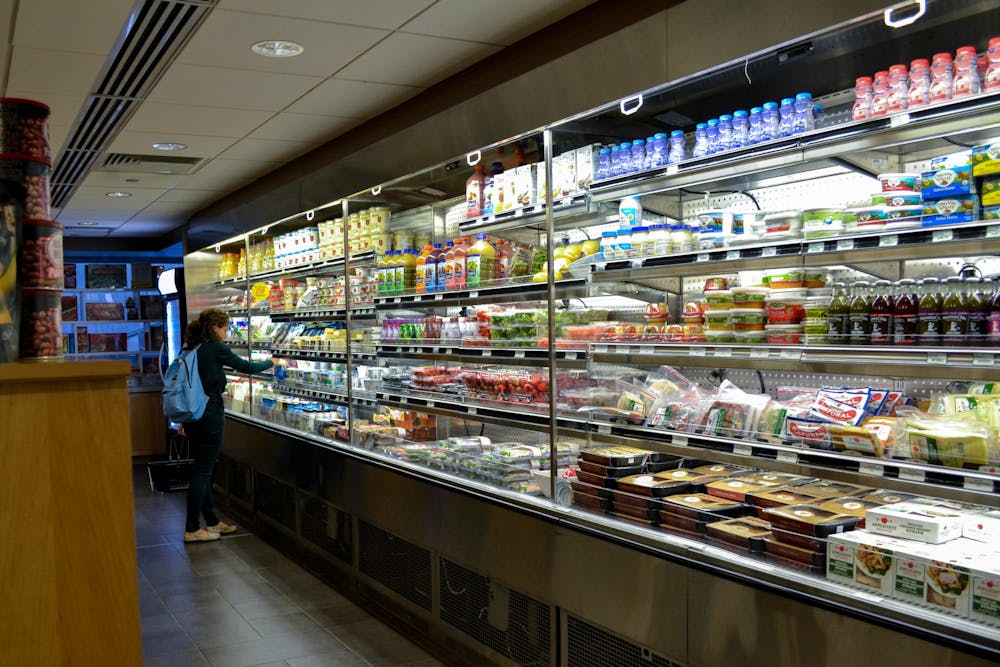
Two apples, a pre-packaged California roll, a bag of chips, a can of Amy’s brand vegetable soup, and a water bottle. This is what I ate on Jan. 16, 2020, all purchased from Gourmet Grocer. All of these items can be paid for using Supplemental Nutrition Assistance Program or an Electronic Benefits Transfer card.
But on Penn’s campus, they couldn’t be. Aside from dining plans which use swipes or dining dollars, Penn’s residential dining facilities accept cash, debit, and credit cards as payment options. But, after a conversation with the director of communications in the division of finance, I was informed that there “are not any financial policies at Penn related to using SNAP/EBT benefits in campus venues,” though there was an expressed interest by the official to explore the option. Considering Penn’s dining halls proudly state that, “At Penn, we recognize that our cafés serve a diverse population with a wide range of dining preferences,” feeding a wide range of socioeconomic mouths is reason enough to search for a way to ensure equal access to food.
Breads, cereals, bottled water, fruits and vegetables, meats, dairy products, seeds and plants, infant formula, some kinds of energy drinks, and pumpkins. These are all the products that you can buy with Pennsylvania Food Stamps. An EBT card is a federally-funded payment option offered at participating stores, that functions similarly to SNAP, except that folks can use an EBT card as many times within the month as they like, instead of all at once. They resemble debit cards in their appearance and their function.
Some Philadelphia fast food places, like the famous Geno’s Steaks, accept EBT cards as a form of payment. But Penn students shouldn’t have to venture to South Street or the nearest Subway restaurant in order to eat when so much time and money has already gone into their local options. Houston Hall, which recently underwent a $15 million dollar renovation, should accept any and all forms of payment, including SNAP and EBT cards. Otherwise, Geno’s Steaks will continue to be a more financially inclusive place than Penn.
Additionally, Wawa, 7-Eleven, Fresh Grocer, and CVS, all near Penn’s campus, also accept SNAP or EBT cards, according to the Fresh EBT app. Nobody wants to struggle with food insecurity. Penn as an institution with seemingly boundless reserves should recognize this very real threat, and help change the possibility of students going hungry. I have been told countless times by countless teachers to eat a “proper breakfast” before an important exam. What if I don’t have the money for a “proper breakfast?" What if an EBT card that can purchase a proper breakfast could offer me one?

Wawa, 7-11, Fresh Grocer, and CVS are among some of the locations around Penn’s campus that accept SNAP or EBT cards.
Humboldt State University in Arcata, California, whose student population is just under 7,000, was one of the first college campuses to accept EBT cards in its campus store in 2016. Four years later, not many college campuses have followed suit. When I read headlines about Mindy Gray and Jon Gray, 1992 graduates, donating 10 million dollars to “fund all tuition and expenses for a group of 10 highly aided students,” my little first-generation low-income heart sings with happiness. While a generous donation, it will realistically impact only 10 students. Altering how Residential dining halls and Houston Hall accept forms of payment could impact far more than 10 students.
If there is no feasible way for Penn to accept SNAP benefits and EBT cards, the least they can do is provide more information to FGLI and food insecure students. Temple University offers a clear and helpful link to food resources through their Care Team website. Yet their Office of University Housing and Residential Life said SNAP benefits and EBT cards are not accepted on campus. After many days and multiple redirections in an attempt to uncover Penn’s policy in regards to SNAP benefits, it became clear that no such information is easily available with Penn online, or through contacting dining hall administration. I understand that 79% of first year Temple students receive financial aid, as compared to the 45% of undergraduate students who receive financial aid at Penn. Just because fewer students are in need of financial help at Penn doesn’t mean their needs are less worthy of being met.
While the Greenfield Intercultural Center “maintains a food pantry students can utilize free of charge for use in meal planning and eating on the go,” I still strongly believe in changing Penn’s ability to accept SNAP and EBT cards. In a country where 12% of residents receive SNAP benefits, excluding highly resourced places from accepting them is perpetuating harmful and classist stratification.

SOPHIA DUROSE is a College junior from Orlando, Fla. studying English. Her email address is sdurose@sas.upenn.edu.
The Daily Pennsylvanian is an independent, student-run newspaper. Please consider making a donation to support the coverage that shapes the University. Your generosity ensures a future of strong journalism at Penn.
Donate




